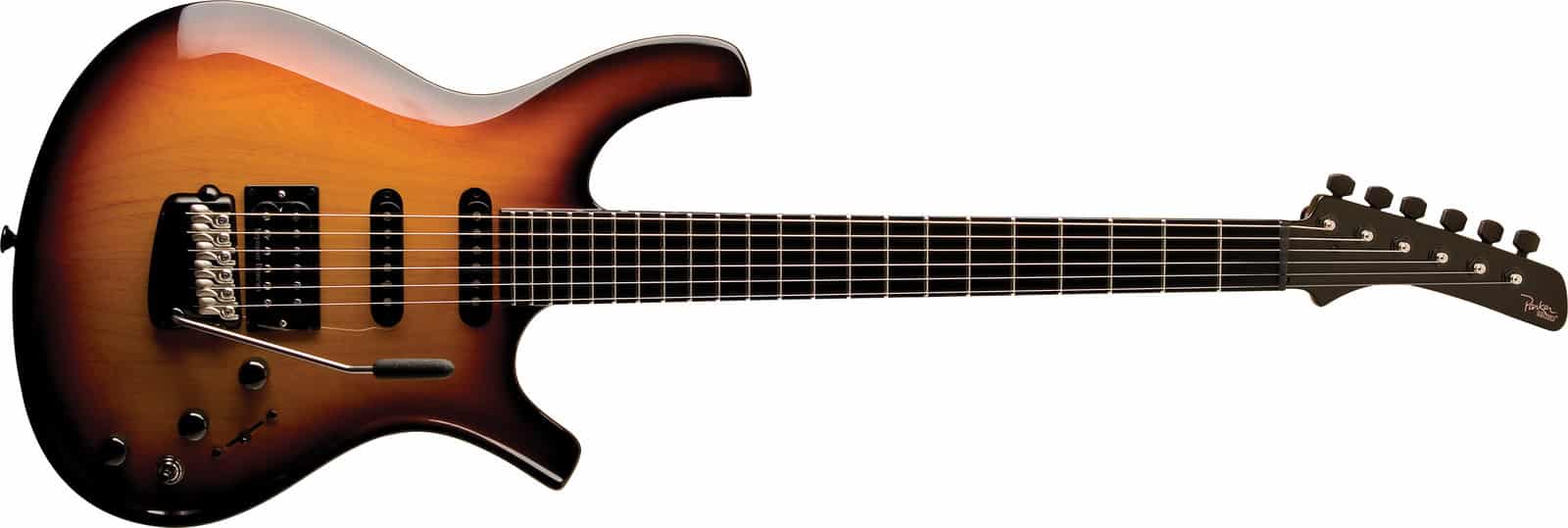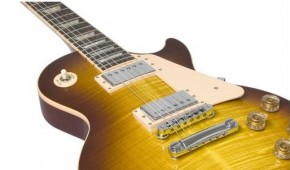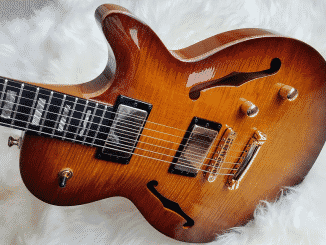
When it was released in the early ‘90s, the Parker Fly won critical accolades for its high-tech construction and futuristic design, making believers out of such dives artists as Adrian Belew, Vernon Reid, Reeves Gabrels, and Pat Martino. A decade after the Fly’s debut, Parker introduced the DragonFly, which featured the same resin-based skin, but made slight changes to the distinctive body design. The treble horn has shorted by about an inch, and the bass horn was straightened and reshaped into a graceful curve, compared with the more angular version on the original. The DragonFly was obviously descended from The Fly, but now had a more traditional look and feel. And at over $4,000 retail, it was still very much a premium guitar.
Enter the DragonFly, Part II
Now Parker has made an even bolder departure. They’ve left the silhouette of the DragonFly intact, but have released three bolt-on versions. DF724 models have beautiful flamed tops while the DF624 models have gloss finishes and the base DF524 guitars have satin finishes. They are identical in body shape and function to the earlier DragonFly, but now feature a separate neck, attached to the body with four large bolts. These three models are much less expensive than the set-net DragonFly, so for anyone who’s always been drawn to the Fly family and who likes bolt-ons, it’s a slam dunk, no brainer call. The bolt-ons capture every bit of the Fly experience but at less than half the cost. The satin Majik blue 524, my review instrument and the least expensive of the three bolt-ons, is almost $2,000 cheaper than the set-net DragonFly. And no, that’s not a typo.
Parker DragonFly Electric Guitar Overview
All Bolt-On models are three-pickup, 22-fret, alder solidbodies that feature the DragonFly’s distinctive carved top, beveled back, and signature double-cutaway horns. Similar to the original Fly, the bevel in the upper horn rolls out gently from the waist to the tip, making it feel a little less conspicuous and a little more comfortable against your chest than the original Fly. A new relief cut at the headstock adds a dash of highlight color and makes the instrument “hangable” on a standard guitar wall hook. Otherwise, when viewed from the front, and in terms of electronic functionality, the bolt-on versions are identical to their higher-end, set-net counterparts.
The neck is made of one-piece maple topped with ebony fingerboard. Unlike the previous DragonFly, the neck materials show through, which makes the DF524 not only look more like a standard guitar but creates a very familiar, organic feel, as your left-hand palm grips the natural-blond maple while your fingertips press on and slide along a plank of oiled ebony. Perfectly dressed, polished stainless steel frets complete the left-hand experience.
While we’re talking about the neck, it should be noted that the profile is still spectacularly thin–0.740” at the 1st fret and 0.780” at the 12th. Terry Atkins, Parker’s V.P. of Manufacturing, informs us that the thin profile harkens back to the original Flys. Despite the visceral experience of feeling the satin-finished maple in your hand, the DF524 has a super-fast neck, owing to the combination of its ultra-shallow depth and radiused fingerboard. With a substantial grip for chords in the lower positions and a smooth ride for lead lines up top, it’s perfectly suited for both virtuoso metalists and traditional blues players alike.
Because maple and ebony are heavier than the basswood components used on the set-neck DragonFly, the bolt-on models are slightly weightier than their predecessor. Remember, though, this is a fly we’re talking about here, so that’s like saying an atom of helium is heavier than an atom of hydrogen. The instrument itself is still perfectly balanced, and some guitar aficionados I showed it to actually preferred the increased heft. “It’s still light, but not too light,” was one quote that represented the consensus.
Parker DragonFly Choice Electronics
The bolt-on DragonFlys have a versatile pickup scheme that includes both magnetic and piezo systems. The magnetics are in a three-pickup S/S/H configuration with two Duncan SSL6A single-coils in the bridge and middle positions and a TB14 humbucker in the bridge. The middle pickup is reverse-polarity/reverse-wound , which creates a nice, rich, phasey sound when used in combination with either the neck or bridge pickup. A pull switch on the Tone knob puts the bridge pickup into single-coil mode for a three-single-coil sound.
Onboard in the bridge is a preamp-driven Fishman piezo transducer that’s controlled by a blend knob. A separate three-way switch brings the piezo into the mix or makes it “piezo-only” for those fingerpicked and acoustic-emulated passages. I like the arrangement in which there is a separate selector switch for the piezo, as it’s the quickest and most versatile way to introduce the piezo into your sound. It also keeps the five-way switch and your magnetic settings completely independent. The output is stereo-capable, meaning you can split the piezo and magnetic paths when using the supplied stereo cable, or you can blend the sound to taste using a normal (mono) patch chord.

I put the DF524 through several amps, including a Fender Vibro-King, an all-tube Bugera V-22, and a Peavey 6550. The breadth of tones was astonishing–tight, throaty low end; punchy midrange; and clear sparkling highs. The combination of the beefier-sounding Duncan SSL6As and the maple neck served up an all-encompassing spectrum of cranking tones, from chunky to searing. Mixing in the piezo on selected clean settings provided the acoustic icing on the cake and sounded great on bright, shiny pop numbers and chickin-pickin’ country solos. Between the wide range of sounds from the magnetics and the three-way piezo capabilities (piezo-only/mix/off), the DragonFly would be your first choice for the one guitar to take when gigging or traveling when circumstances dictate that you can bring only one.
Parker DragonFly Electric Guitar Video Review
The DragonFly Takes Wing
Several steps have been taken to bring the DF524 into the realm of the affordable for the largest number of players. The bolt-on neck is simply a less expensive way to manufacture any electric guitar, and especially a Fly, where the resin coating is very labor-intensive. The three-spring tremolo (as opposed to the flat-spring version) and satin finish bring the price down further still, yet I find the satin finish has an understated beauty that complements the modern silhouette. In every other aspect–build quality, electronics, aesthetics–the DF524 performs to the expectations of the set-net instruments. This excellently crafted and versatile-sounding guitar is now well within that sweet spot of the under-$1,500 price point. And that is going to convert a lot of guitar players.





True Nerd Guitar! They changed the body because the original Flys were so poorly designed. And who really needs a piezo? Just use an acoustic simulator effect! No truly popular mainstream popular guitarist use Parkers. Where’s this model made? That should be revealed in every guitar reviw!
@Jones
actually i don’t think that being mainstream and being good guitarist is anyhow connected…
Yeah Parker guitars are not very sexy to me. I appreciate the guitar company does something different tho-